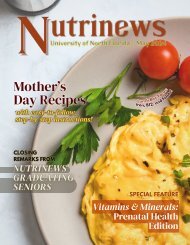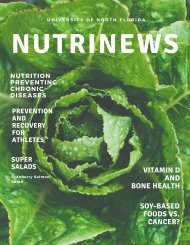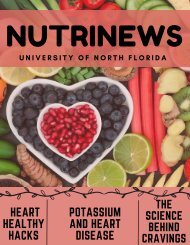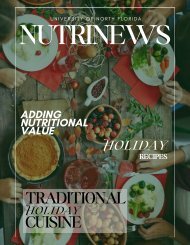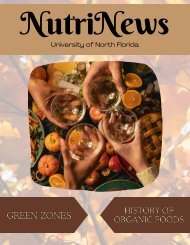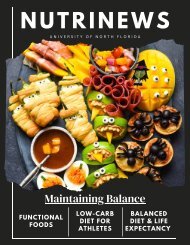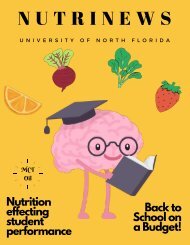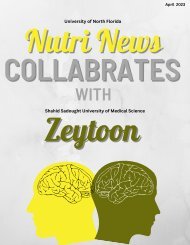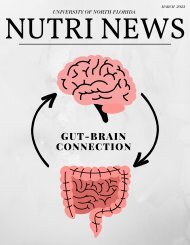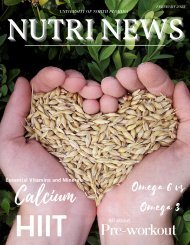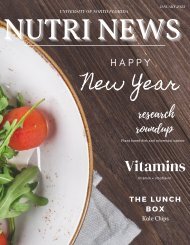Nutri News May 2023
May Issue This month Theme is “The Culture Behind our Food “ • Two essential minerals: Iodine and Phosphorus. Check your essential guide to vitamin and mineral to learn about the function of these mineral. • Check out page 10 if you want to learn how our culture influences our eating behaviors and our choice in favorite/comfort foods. • “Food Culture” Check page 14 to learn more about this rising subject! • Eating disorder prevalence among women • You will never want to buy store granola after trying this recipe. Check out the lunch box article for a delicious vegan recipe that the entire family will love! • If you want to learn how to include your favorite family recipes in your everyday meals check our monthly hacks article! • Let’s talk about myths surrounding kimchi and soy. Check page 20 for more! • Have you heard the terms Cultural competence and cultural humility, but don’t know what they really mean. Check our research round up article to learn more! Throughout the magazine you will find special interviews with our editor in chief, co-editor in chief, and head publisher! Check out the student spotlight to learn about these three bright women! If you are looking to make an impact on campus as well as in the community, look for the fliers highlighting volunteer opportunities. These amazing programs are always looking for more volunteers. It is amazing the difference we can make when we all work together for a better and healthier tomorrow.
May Issue
This month Theme is “The Culture Behind our Food “
• Two essential minerals: Iodine and Phosphorus. Check your essential guide to vitamin and mineral to learn about the function of these mineral.
• Check out page 10 if you want to learn how our culture influences our eating behaviors and our choice in favorite/comfort foods.
• “Food Culture” Check page 14 to learn more about this rising subject!
• Eating disorder prevalence among women
• You will never want to buy store granola after trying this recipe. Check out the lunch box article for a delicious vegan recipe that the entire family will love!
• If you want to learn how to include your favorite family recipes in your everyday meals check our monthly hacks article!
• Let’s talk about myths surrounding kimchi and soy. Check page 20 for more!
• Have you heard the terms Cultural competence and cultural humility, but don’t know what they really mean. Check our research round up article to learn more!
Throughout the magazine you will find special interviews with our editor in chief, co-editor in chief, and head publisher! Check out the student spotlight to learn about these three bright women!
If you are looking to make an impact on campus as well as in the community, look for the fliers highlighting volunteer opportunities. These amazing programs are always looking for more volunteers. It is amazing the difference we can make when we all work together for a better and healthier tomorrow.
Create successful ePaper yourself
Turn your PDF publications into a flip-book with our unique Google optimized e-Paper software.
U N I V E R S I T Y O F N O R T H L O R I D A<br />
M A Y 2 0 2 3<br />
NUTRINEWS<br />
M A G A Z I N E<br />
LUNCH<br />
BOX<br />
The Best<br />
Granola<br />
ESSENTIAL<br />
VITAMINS AND<br />
MINERALS<br />
Iodine &<br />
Phosphorus<br />
NUTRITION<br />
RESEARCH<br />
Cultural Foods<br />
Influence
TABLE OF CONTENT<br />
"FOOD IS RATIONAL. FOOD IS CULTURE,<br />
HABIT, CRAVING AND IDENTITY."<br />
Johnathan Safran Foer<br />
04.<br />
YOUR ESSENTIAL GUIDE TO VITAMINS<br />
AND MINERALS<br />
Iodine and Phosphorous<br />
INTERVIEW WITH EDITOR IN CHIEF<br />
08. Saily Matero<br />
10.<br />
14.<br />
NUTRITION RESEARCH<br />
How culture influences our eating<br />
behaviors and the food we eat<br />
NUTRITION HISTORY RESEARCH<br />
Food Culture<br />
INTERVIEW WITH CO-EDITOR IN CHIEF/TREASURER<br />
16. Georgina Brace<br />
18.<br />
19.<br />
20.<br />
22.<br />
THE LUNCH BOX<br />
The Best Granola<br />
MONTHLY HACKS<br />
Culture Foods and a Healthy Diet<br />
MYTHBUSTING<br />
Cultural Cuisine - Kimchi<br />
RESEARCH ROUND UP<br />
Cultural Competence and Humility<br />
INTERVIEW WITH HEAD PUBLISHER<br />
26. Priscilla Stevens<br />
30.<br />
NUTRINEWS STAFF
Your Essential Guide to<br />
Vitamins and Minerals<br />
Iodine and Phosphorus<br />
Written by:<br />
Ashley Valle<br />
What is iodine & What roles does it play in the body?<br />
Iodine is a mineral that is essential for our<br />
thyroid hormones1, you may have heard<br />
of “iodized salt” or read an ingredient<br />
label and found that it contains a<br />
variation of “iodate” or “iodide”. This<br />
mineral is essential not only for thyroid<br />
hormone balance, but also for prenatal<br />
and newborn development, cognitive<br />
performance throughout childhood, and<br />
fibrocystic breast disease.1<br />
The reason for its importance in fetal and<br />
infant growth and development is due to<br />
the higher sensitivity to iodine deficiency<br />
that infants experience, and the reliance<br />
on maternal T4 during pregnancy. T4 is<br />
thyroxine, thyroxine is stimulated by<br />
thyroid-stimulating hormone (TSH) which<br />
controls the secretion of thyroid<br />
hormone. Without enough iodine, TSH<br />
remain high and can cause goiter,<br />
inflammation of the thyroid.<br />
As previously mentioned, iodine<br />
deficiency during childhood affects<br />
cognitive function, with the possibility of<br />
even reducing children’s IQ by 12-13.5<br />
points if it is severe iodine deficiency1.<br />
Further research is needed for the<br />
quantification of the impact of mild<br />
iodine deficiency on cognitive function in<br />
children.<br />
Although data is limited, iodine<br />
supplementation has shown promising<br />
results in the prevention of fibrocystic<br />
breast disease1. Due to breast tissue<br />
containing a lot of iodine, this<br />
supplementation is shown to reduce the<br />
pain associated with Fibrocystic breast<br />
disease1.<br />
4
If a person become iodine deficient, goiter may occur<br />
as previously mentioned as well as hypothyroidism.<br />
Other possibilities include miscarriage, stillbirth,<br />
intellectual disability, stunted growth, and other<br />
abnormalities.<br />
Excessive intake of iodine can result in goiter,<br />
hypothyroidism, and even hyperthyroidism. Other<br />
possibilities include thyroiditis and even thyroid<br />
papillary cancer or iodine poisoning which can result<br />
in abdominal pain, weak pulse, coma, vomiting,<br />
burning of the mouth, and more1.<br />
RDA Recommendations for Iodine1<br />
What is Phosphorus?<br />
Phosphorus is another<br />
essential mineral that is<br />
responsible for gene<br />
transcription,<br />
maintenance of pH, and<br />
enzyme activation2. It is<br />
also a large component<br />
of our bones and teeth<br />
and plays roles in the<br />
function of our kidneys,<br />
contraction of muscles,<br />
nerve signaling, and<br />
regulation of the<br />
heartbeat3.<br />
Dietary sources of Iodine1<br />
Enriched bread<br />
Cod<br />
Seaweed<br />
Oysters<br />
Green plain yogurt<br />
Milk<br />
The discussion of<br />
phosphorus is a large<br />
topic in the world of<br />
chronic kidney disease. A<br />
times, patients are<br />
recommended a “low<br />
phosphorus” diet, this is<br />
because as the function<br />
of the kidneys<br />
deteriorates, their ability<br />
to filter out phosphorus<br />
becomes less efficient.<br />
However, this should be<br />
about reducing foods<br />
with high phosphorous<br />
bioavailability, such as<br />
coca cola and highly<br />
processed foods rather<br />
than removing food<br />
containing phosphorus<br />
but with lower<br />
bioavailability such as<br />
dark leafy greens or<br />
other fruits and<br />
vegetables2.<br />
5
What happens if we are deficient in<br />
phosphorus? What happens if we take in too<br />
much?<br />
Phosphorus deficiency in the United States is rarely<br />
caused by insufficient dietary intake2, it is usually<br />
cause by diabetic ketoacidosis,<br />
hyperparathyroidism, ad kidney tubule defects2.<br />
People at risk of developing phosphorus<br />
deficiency (hypophosphatemia) are patients with<br />
severe malnutrition. This is because they are more<br />
at risk for developing refeeding syndrome, a<br />
condition caused by being fed too much, too fast,<br />
after an extended period of malnourishment.<br />
Other groups at risk for the development of<br />
hypophosphatemia are preterm newborns2. This is<br />
due to two-thirds of fetal bone mineral content<br />
being developed in the final trimester of<br />
pregnancy2. When they are born prematurely, they<br />
are born with low calcium and phosphorus stores.<br />
Another group of people at risk for the<br />
development of hypophosphatemia re people with<br />
genetic phosphate regulation disorders, these are<br />
rare but possible and may result in osteomalacia,<br />
dental fractures and more2.<br />
RDA Recommendations for Phosphorus<br />
Dietary Sources of<br />
Phosphorous2<br />
Yogurt<br />
Milk<br />
Salmon<br />
Scallops<br />
Cheese<br />
Lentils<br />
Cashews<br />
References:<br />
1. Office of dietary<br />
supplements - iodine. NIH<br />
Office of Dietary Supplements.<br />
https://ods.od.nih.gov/factshe<br />
ets/Iodine-<br />
HealthProfessional/.<br />
2. Office of dietary<br />
supplements - phosphorus.<br />
NIH Office of Dietary<br />
Supplements.<br />
https://ods.od.nih.gov/factshe<br />
ets/Phosphorus-<br />
HealthProfessional/#h2.<br />
3. Phosphorus in Diet:<br />
Medlineplus medical<br />
encyclopedia. MedlinePlus.<br />
https://medlineplus.gov/ency/<br />
article/002424.htm.<br />
6
Happy Mother's<br />
Day<br />
M A Y 1 4 , 2 0 2 3
Interview with Saily<br />
Medero, Editor in Chief<br />
Saily Medero, B.S. in <strong>Nutri</strong>tion and Dietetics<br />
What sparked the want in you to become a<br />
register dietitian?<br />
My curiosity about this subject started to grow was<br />
after I joined the military. The Army, like any other<br />
branch has many physical requirements that<br />
service members must meet and to meet those<br />
requirements you have to know how to fuel your<br />
body. A year into my military career I was going to<br />
college to become a dental hygienist and one of<br />
the prerequisites was introduction to nutrition.<br />
When I took that class, that’s when it all clicked<br />
into place for me, and my curiosity grew<br />
tremendously. As my curiosity continued to grow, I<br />
started to research topics that interested me and<br />
that’s when I decided that dietetics was my<br />
passion, I could never get bored of it, learning<br />
about it didn’t felt like a chore or something I had to<br />
do, there is always something new to learn, is<br />
constantly evolving, and the opportunities for a<br />
register dietitian are endless so I decided to<br />
change my major and started the journey to<br />
becoming a register dietitian. Now 3 years, I still<br />
feel the same way. I’m still in love with this field.<br />
What has been the most challenging part of your journey so far?<br />
The most challenging part of this journey for me has been learning to balance my work/school life with<br />
my personal life and learning to take care of myself first. Our field is full of high achievers, and this is a<br />
very competitive program, especially when it comes to internship. A 4.0 GPA is simply not enough, you<br />
have to participate in club, you have to volunteering, and you have to maintain your grades. Is a process<br />
to learn what works for you and how to take on enough but not too much to the point that you are burn<br />
out due to the many responsibilities you have.<br />
8
What are your goals for the future after you graduate?<br />
My first goal after graduating is passing my RD exam and getting a job working with eating disorders. I<br />
also need a vacation, hopefully I can do that soon!!!!!!<br />
What part of being a member of the <strong>Nutri</strong><strong>News</strong> family has been your favorite, and how has this<br />
experience influenced your view about nutrition?<br />
My favorite part has been working with so many different people and actually getting to know them. <strong>Nutri</strong><br />
<strong>News</strong> has helped me to build meaningful and hopefully long-lasting relationships. The main way this<br />
experience has shaped my view of nutrition is that we all have different views and opinions about nutrition<br />
subjects and problems within the field and how to go about solving those problems.<br />
What is something you learned while in <strong>Nutri</strong> <strong>News</strong> that you will continue to use?<br />
Patience, a lot of patience!!! Joking, <strong>Nutri</strong> <strong>News</strong> has definitely developed my research and leadership skills<br />
which I have no doubt I will continue to use.<br />
What would you tell the student in the program or thinking about joining this program?<br />
I will tell them to ask questions, reach out to your professor and pick their brains, always ask for help, the<br />
worst thing that can happen is that they say they can’t help you. I live by that philosophy, and only once<br />
have I had a professor turn me down from the many many times I have reach out.<br />
9
<strong>Nutri</strong>tion Research<br />
How Culture<br />
Influences Our<br />
Eating Behaviors<br />
& the Food We<br />
Eat<br />
Written By:<br />
Sofie Van Moorleghem<br />
Our upbringing and environment are known to<br />
influence how we interact with food and what<br />
we consume. Culture also plays a role in this<br />
since it may aid in identifying someone's belief<br />
system or background. Understanding and<br />
recognizing how a cultural group's traditional<br />
meals and eating patterns influence them is<br />
important since it may aid with healthier choices<br />
while maintaining the same traditional foods.<br />
Society and cultural backgrounds influence<br />
greatly how people make their everyday food<br />
decisions so making sure that they are heard<br />
and understood is the best way to keep that<br />
consideration when making healthy meal<br />
choices for all.<br />
Growing up in various cultures influences how<br />
people live their lives, and the most impactful<br />
factor in our life has to be our food. This is why<br />
having a cultural relationship with food may<br />
help families connect. However, the biggest<br />
difficulty with cultural influences has been the<br />
health dangers associated with the cuisines<br />
from those different cultures.This is why it is<br />
important to include not just cultural<br />
cuisine, but also to combine those culturally<br />
relevant meals with healthier diversified<br />
meals in order to keep various nationalities<br />
healthy while keeping committed to their<br />
cultural eating habits. An example that has<br />
sprung up a couple of times is the<br />
correlation between southern-style fried<br />
foods and African American eating<br />
behaviors leading to heart disease and<br />
diabetes. Nonetheless, this type of southern<br />
eating doesn't need to be unhealthy as<br />
there are lots of options that can still be<br />
culturally relevant and be involved in<br />
healthy eating. Figuring out how to merge<br />
healthy eating with cultural foods and<br />
eating behaviors is important in the world of<br />
nutrition and dietetics as doing this will help<br />
connect people to a healthier lifestyle whilst<br />
making sure they are still comfortable with<br />
their ethnicity’s foods.1<br />
10
Research has shown that many people with<br />
similar cultural backgrounds have similar ways<br />
in which they eat especially with flavors and<br />
dishes. So, with increased immigration, most<br />
people have changed their eating habits to<br />
Americanized ways of eating their cultural<br />
foods. Research from the Hartman Group’s<br />
Exploring the Diversity of American Foodways<br />
Report has found that the general population<br />
of immigrants has adopted American-style<br />
food values, particularly in their eating<br />
behaviors. For example, the behaviors tend to<br />
skew towards having convenience foods with<br />
frequent snacking and selections of a larger<br />
array of different types of food depending on<br />
the occasion. However, this doesn't mean that<br />
they don't cook, as immigrants tend to do<br />
more cooking (as a group as well) whilst using<br />
more produce and fresher foods than the<br />
average Americans.2<br />
As a result, even today, behaviors might vary<br />
based on culture, as well as where individuals<br />
reside. So, although having cultural traditional<br />
meals and eating patterns might remind<br />
someone of their history, it is vital to note that<br />
everyone can change and that doing so does<br />
not damage one's culture. It's nice to try new<br />
dishes from other cultures, and variety should<br />
be promoted since it allows us to see other<br />
people's experiences and origins. Traditional<br />
cuisines and eating habits are a little lens that<br />
may help us view each other in a new light, and<br />
they should be shared and cherished more.<br />
Many factors contribute to creating diets for<br />
future generations; culture is one of the most<br />
important, and at times the most influential.<br />
Currently, we see more modern eating habits<br />
than cultural eating, which may lead to more<br />
harmful refined meals instead of culturally<br />
rich nutritious foods. This is why having more<br />
traditional meals is important not just for<br />
festivals or special events, but also for<br />
maintaining a healthy and culturally<br />
enriching diet. As of now, there is something<br />
called the heritage pyramid which outlines<br />
healthy food groups in different ethnicities<br />
like Asian, Latin American, African, etc. This<br />
can help with stopping the idea of cultural<br />
food being “bad for you” whilst giving people<br />
a healthy look at foods from their<br />
background.3 Food is an important part of<br />
one’s history. So, to preserve this and ensure<br />
that we keep our culture alive, making<br />
traditional foods a part of our everyday lives<br />
is a good place to start.<br />
References:<br />
1. How Culture Affects Diet | Livestrong.com. LIVESTRONG.COM. Published June 22, 2011. https://www.livestrong.com/article/476301-how-culture-affects-diet/Accessed April 1, <strong>2023</strong>.<br />
2. Demerritt, L. Cultural background’s influence on how we eat. SmartBrief. Published June 3, 2020. https://corp.smartbrief.com/original/2020/06/cultural-backgrounds-influence-how-we-eat.<br />
Accessed April 1, <strong>2023</strong>.<br />
3. Baer-Sinnott S. Food Is a Window to Cultural Diversity. US <strong>News</strong> & World Report. Published 2020 https://health.usnews.com/health-news/blogs/eat-run/articles/food-is-a-window-to-culturaldiversity.<br />
Accessed April 1, <strong>2023</strong>.<br />
11
Happy Memorial<br />
Day<br />
M O N D A Y M A Y 2 9 , 2 0 2 3<br />
In honor to those who died serving in the<br />
United States military!
Congratulations<br />
CLASS OF <strong>2023</strong><br />
You did it!
N U T R I T I O N H I S T O R Y R E S E A R C H<br />
F O O D C U L T U R E<br />
What is “food culture”? Put simply,<br />
food culture is the set of beliefs,<br />
values, and practices that are<br />
centered around food.1-2 A specific<br />
food culture is shaped by things such<br />
a lifestyle, tradition, heritage, society,<br />
location, climate, and income, and it<br />
can be influenced by small networks<br />
(e.g. families) or large networks (e.g.<br />
societies, companies, countries).1 This<br />
culture surrounding food spans from<br />
the growth of food to its production,<br />
procurement, preparation, and finally<br />
consumption, and it is a very powerful<br />
thing<br />
What we eat has an impact on our life<br />
that goes far beyond the role of<br />
energy and fuel to survive. Food<br />
brings a level of happiness and<br />
comfort; it is a way of bonding with<br />
not only those around us but also<br />
those of generations past, and it is a<br />
source of income for many. Our<br />
relationship with food is deep and<br />
personal and can trigger powerful<br />
emotions. Food helps to shape<br />
identity and purpose in both<br />
individuals and groups and is<br />
consequentially a cornerstone of<br />
many cultures.<br />
Written By:<br />
Isabelle Brazelton<br />
“ F o o d i s f o r g i f t i n g . I t<br />
p r o v i d e s u s t h e b a s i s t o<br />
c o n n e c t w i t h o u r f r i e n d s<br />
a n d f a m i l y . I t i s m o r e t h a n<br />
j u s t p l a i n n u t r i t i o n ; f o o d<br />
w h e n s h a r e d a n d ' g i f t e d '<br />
b r i n g s p e o p l e , s o c i e t i e s , a n d<br />
n a t i o n s c l o s e r . ”<br />
<br />
– M a r g a r e t M e a d 1<br />
14
Different food cultures can vary widely, and many are continuously evolving. For<br />
example, western food cultures such as American food culture are dynamic and<br />
change based on growing demands and influence from generations of other<br />
food cultures. While there are staple foods in American culture such as<br />
hamburgers, sodas, and fries, there is also a strong prevalence of Chinese,<br />
Mexican, Italian, Indian, Thai, French, Filipino, Spanish, Korean, Japanese, and<br />
South African cuisines in America. These cuisines from around the world grow in<br />
popularity daily, with new interpretations and combinations of them emerging<br />
constantly<br />
This ever-changing blending of different food cultures in America creates a<br />
continuing demand for different foods.3 Food manufacturers have to<br />
constantly adapt to what is current and popular. Luckily, modern-day transport<br />
and technology make it easier than ever to support various evolving food<br />
cultures and product demands. Now more than ever we are able to have almost<br />
any food imaginable. This in itself allows for more complex and shifting food<br />
cultures to emerge.<br />
<br />
R e f e r e n c e s<br />
<br />
1 . J o h n s o n S . F o o d C u l t u r e : M e a n i n g , R e l a t i o n s h i p s , a n d I m p o r t a n c e .<br />
S t u d y . c o m . P u b l i s h e d 2 0 2 2 .<br />
h t t p s : / / s t u d y . c o m / l e a r n / l e s s o n / d i f f e r e n t - f o o d - c u l t u r e s -<br />
r e l a t i o n s h i p s -<br />
i m p o r t a n c e . h t m l # : ~ : t e x t = F o o d % 2 0 c u l t u r e % 2 0 i s % 2 0 t h e % 2 0 c o l l e c t i v e<br />
<br />
2 . F o o d C u l t u r e W h a t I s I t ? x y u a n d b e y o n d . P u b l i s h e d A p r i l 7 , 2 0 2 2 .<br />
h t t p s : / / x y u a n d b e y o n d . c o m / f o o d - c u l t u r e /<br />
<br />
3 . F o o d w a y s . F o o d w a y s - a n o v e r v i e w | S c i e n c e D i r e c t T o p i c s .<br />
h t t p s : / / w w w . s c i e n c e d i r e c t . c o m / t o p i c s / f o o d -<br />
s c i e n c e / f o o d w a y s # : ~ : t e x t = T h e % 2 0 A m e r i c a n % 2 0 e t h n o l o g i s t % 2 0 L u c y %<br />
2 0 L o n g , % E 2 % 8 0 % 9 D % 2 0 ( L o n g % 2 C % 2 0 2 0 1 5 ) . A c c e s s e d M a r c h 2 7 , 2 0 2 3 .<br />
15
Interview with Co-Editor<br />
in Chief and Treasurer,<br />
Georgina Brace<br />
Georgina Brace, B.S. in <strong>Nutri</strong>tion and Dietetics<br />
What sparked the want in you to become a<br />
registered dietitian?<br />
I've always had a deep-seated interest in both<br />
healthy eating and helping others in the<br />
community. However, when I was sitting in class<br />
on the first day of my nutrition class, which was<br />
part of my public health degree, the professor,<br />
who is a registered dietitian, was discussing how<br />
nutrition plays a significant role in public health.<br />
Until she introduced herself, I had never heard of<br />
a registered dietitian; nevertheless, once she<br />
did, my attention was immediately drawn to the<br />
topic. As the semester progressed, I had a better<br />
understanding of the work that my professor did<br />
and of the ways in which I could combine my<br />
interests in nutrition and community service.<br />
Despite the fact that I only had one semester<br />
remaining to complete my bachelor's degree, I<br />
decided to pursue a second bachelor's degree in<br />
nutrition and dietetics while working as an intern<br />
for a local dietitian over the summer. After<br />
completing the first semester of this degree<br />
program, I had the sensation of finally being at<br />
home and realized that becoming a registered<br />
dietitian was the path I was always intended to<br />
follow, and the following semester only<br />
confirmed that for me.<br />
16
What has been the most challenging part of your journey so far?<br />
The most difficult aspect of my journey has been juggling the responsibilities of being a single mother,<br />
attending school full-time, maintaining a satisfactory grade point average, participating in extracurricular<br />
activities such as research and volunteering, and holding leadership positions. On the other hand, I believe<br />
that this experience has demonstrated to me how much I am capable of doing and how dedicated I am.<br />
What are your goals for the future after you graduate?<br />
I will be attending the University of South Florida once I have my bachelor's degree to pursue a master's<br />
degree in public health with a specialization in nutrition. Concurrently, I will be interning at the Bay Pines<br />
Veterans Affairs Medical Center in Tampa, Florida. After completion of my internship, one of my goals is to<br />
find a permanent position in the VA system. My aspirations for the far future include working toward a<br />
faculty position in higher education and launching my own private dietetics practice.<br />
What part of being a member of the <strong>Nutri</strong><strong>News</strong> family has been your favorite, and how has this<br />
experience influenced your view about nutrition?<br />
The biggest benefit of being a part of the <strong>Nutri</strong><strong>News</strong> family for me is getting to know everyone on the team<br />
and observing how they collaborate with one another. In addition, I believe that participating in <strong>Nutri</strong><strong>News</strong><br />
gave me the opportunity to get to know people that I perhaps wouldn't have talked to in the classroom and<br />
assisted me in developing other relationships. Reviewing the works of other people, seeing how they<br />
interpret the world and how they express themselves creatively is another one of my favorite parts to this<br />
team. My perspective on nutrition has been altered as a result of this experience due to the fact that not<br />
everyone has the same ideas when it comes to nutrition, and the fact that hearing the perspectives of<br />
other people on nutrition will assist me in maintaining an open mind while working in this industry.<br />
What is something you learned while in <strong>Nutri</strong><strong>News</strong> that you will continue to use?<br />
During my time at <strong>Nutri</strong><strong>News</strong>, I realized how important it is to work well with others. I would not have<br />
been able to understand what it is like to have a family unit if it were not for the assistance of my<br />
classmates and the collaboration that they gave. Everyone on the <strong>Nutri</strong><strong>News</strong> team plays an important<br />
role, and we have a fantastic relationship with one another. I am going to keep utilizing this structure for<br />
working in teams, and I am going to constantly remind myself that it is acceptable to seek aid when I am<br />
in need of it.<br />
Any advice for a student in the program or thinking about joining this program?<br />
I would advise students to become engaged above all else since it not only enhances your resume and<br />
DICAS applications, but it also enables you to network with teachers and other students. By being active<br />
outside of the classroom, you may also develop incredibly strong soft skills. I was able to improve my<br />
leadership, public speaking, time management, problem-solving, and team-working abilities. I would also<br />
advise students to get to know their professors well since, despite them being intimidating at first , they<br />
really care about their students' achievement. I hope that the close connections I have formed with my<br />
professors will last and that they will continue to serve as my mentors as I progress in my profession.<br />
17
The Lunch Box<br />
The Best<br />
Granola<br />
Written By:<br />
Kate Overby<br />
You'll never want to buy store-bought granola<br />
again after making your own at home! It's<br />
delicious on its own, with milk, or as a topping<br />
for yogurt or a smoothie bowl. Feel free to add<br />
your favorite nuts, seeds, and dried fruit to<br />
your recipe. You can't go wrong with this!<br />
The base of this granola recipe comes directly<br />
from Andrea Hannemann’s incredible<br />
cookbook, “Plant Overby Processed”. After<br />
making it weekly for over a year, the nuts,<br />
seeds, coconut, chocolate chips, and dried<br />
cranberries are my personal favorite add ins.<br />
Ingredients:<br />
-1/3 cup maple syrup<br />
-1/3 cup coconut sugar<br />
-4 tsp vanilla<br />
-½ tsp salt<br />
-½ cup melted coconut oil<br />
-5 cups rolled oats<br />
-1 cup chopped almonds<br />
-1 cup chopped walnuts<br />
-1 cup raw pumpkin seeds<br />
-1 cup unsweetened coconut flakes<br />
-1 cup dark chocolate chips<br />
-1 cup dried cranberries<br />
Instructions:<br />
1.Preheat oven to 325 degrees F<br />
2.Line a baking sheet in aluminum foil<br />
3.In a large bowl combine all ingredients<br />
except dried cranberries<br />
4.Pour mixture onto lined baking sheet and<br />
use clean hands to evenly spread and<br />
compress the mixture onto the baking sheet<br />
5.Bake for 17 minutes and then rotate the<br />
baking sheet and bake for another 17 minutes<br />
6.Remove granola from oven and let cool<br />
completely<br />
7.Spoon granola into a large bowl and mix in<br />
the dried cranberries<br />
8.Store in an airtight container for no more<br />
than 3 weeks<br />
18
Written By:<br />
Sophia Harris<br />
MONTHLY HACKS<br />
HOW TO INCLUDE CULTURAL FOODS<br />
INTO A HEALTHY DIET<br />
Adding dishes from your culture may seem<br />
difficult at first, but with enough experience, it<br />
will become as natural as breathing. Many<br />
cultures have dishes that call for frying. While<br />
that specific cooking process produces great<br />
food, it is not particularly healthy to consume it<br />
on a regular basis. If you are able, try<br />
experimenting with healthier cooking methods<br />
like steaming, braising, boiling, or baking them.1<br />
Another useful approach is to become more<br />
conscious of your meal portions 1 Try to include<br />
more veggies into your meals to increase fullness<br />
and minimize the quantity of saturated fats in<br />
your meal.1<br />
By following these tips, you will allow yourself to<br />
focus on intaking the healthy vitamins and<br />
minerals from both the starches and the<br />
vegetables. Another option is to use additional<br />
herbs and spices in your recipes to enhance<br />
taste.1 Adding more fruit and vegetables to the<br />
traditional recipes can also make it healthier and<br />
to make your meal more balanced.1 Swapping<br />
whole grains for refined food products can also<br />
aid in the absorption of more vitamins and<br />
minerals that the whole grains have than the<br />
refined foods.1 I also think that using the<br />
MyPlateKitchen from the USDA could potentially<br />
be useful when creating healthy recipes while<br />
still incorporating your traditional foods in<br />
your diet.2 MyPlateKitchen is an online tool<br />
that can be used to help you make recipes<br />
that are healthy without breaking the bank.2<br />
They also include recipes from different<br />
cultures as well from Asian to Mediterranean<br />
to Latino.2 There are other resources that the<br />
USDA website that may help with healthy<br />
eating while incorporating food a different<br />
culture.2 These include: MyNativePlate,<br />
Actions for Individuals and Families, Delicious<br />
Heart Healthy Eating, etc.2<br />
A PDF from the IHSS Training Academy<br />
contains a list of common dishes from three<br />
distinct cultures.3 Despite the fact that this is<br />
a pretty generic list, I believe it might help<br />
generate ideas for new/inspired meals using<br />
classic items.3 This website may also help you<br />
decide which foods to include to your cultural<br />
diet. 3 It is important to remember that there<br />
is no such thing as "good" or "bad" foods,<br />
especially when it comes to ethnic delicacies.<br />
It is feasible to maintain a healthy diet while<br />
consuming foods from your own culture. I feel<br />
that these tools may help people on their way<br />
to a better cultural diet by allowing them to<br />
try new cuisines. I hope that this can be a<br />
useful guide to exploring different ingredients<br />
to add to your diet. Happy exploring!<br />
Resources<br />
1.Amidor T. How to Optimize Your Culture’s Diet for Health. U.S. <strong>News</strong> website. Published March 16, 2018. Accessed April 1, <strong>2023</strong>. https://health.usnews.com/health-news/blogs/eatrun/articles/2018-03-16/how-to-optimize-your-cultures-diet-for-health<br />
2.USDA <strong>Nutri</strong>tion authors. Culture and Food. USDA <strong>Nutri</strong>tion.gov website. Accessed April 1, <strong>2023</strong>. https://www.nutrition.gov/topics/shopping-cooking-and-meal-planning/culture-and-food<br />
IHSS Training Academy authors. Cultural Considerations in <strong>Nutri</strong>tion and Food Preparation. Accessed April 1, <strong>2023</strong>.<br />
https://www.cdss.ca.gov/agedblinddisabled/res/VPTC2/9%20Food%20<strong>Nutri</strong>tion%20and%20Preparation/Cultural_Consider_in_<strong>Nutri</strong>tion_and_Food_Prep.pdf<br />
19
MYTHBUSTING<br />
CULTURAL CUISINE<br />
Kimchi<br />
<br />
WRITTEN BY:<br />
DAHNINE MCCUNE-MOYER<br />
Kimchi is a traditional Korean side dish made from fermented<br />
vegetables, typically Napa cabbage, radish, or cucumber, mixed with a<br />
variety of seasonings, including garlic, ginger, chili peppers, and fish<br />
sauce. This popular Korean food has become increasingly popular<br />
around the world due to its unique flavor and potential health benefits.1<br />
<br />
Kimchi has been a staple in Korean cuisine for centuries and is an<br />
integral part of the country's culinary heritage. It is typically eaten with<br />
rice or as a side dish with meat or fish. It is also used as an ingredient in<br />
other Korean dishes, such as kimchi fried rice or kimchi soup.<br />
<br />
Kimchi is often associated with Korean culture and cuisine but is also<br />
enjoyed in other Asian countries, such as China and Japan. Its<br />
popularity has also spread to other parts of the world, including the<br />
United States, where it has gained a following among health-conscious<br />
consumers.<br />
<br />
There are several nutrition myths associated with kimchi. One common<br />
misconception is that it is high in sodium. While it is true that kimchi<br />
can be salty, the sodium content in the kimchi has been found to<br />
reduce the pathogenic E. Coli.2 Another myth is that kimchi is high in<br />
calories. However, it is actually low in calories and rich in fiber, vitamins,<br />
and minerals.<br />
In conclusion, kimchi is a flavorful and nutritious dish that has been<br />
enjoyed in Korea for centuries and is now gaining popularity around the<br />
world. While there are some myths associated with its nutritional<br />
content, it can be a healthy addition to a well-balanced diet.<br />
20
Soy<br />
Soy foods are a staple in many cultures around the world,<br />
particularly in Asia, where soybeans have been a dietary<br />
staple for thousands of years. Soy foods come in many<br />
different forms, including tofu, soy milk, tempeh, and soy<br />
sauce.<br />
Soy foods are particularly popular in countries such as<br />
China, Japan, and Korea, where they are often used as a<br />
source of protein in vegetarian or low-meat diets.<br />
Soybeans are also widely grown and consumed in other<br />
parts of the world, including the United States and<br />
Brazil.<br />
There are several nutrition myths associated with soy foods. One<br />
common misconception is that soy products can increase the risk<br />
of breast cancer in women. However, there is no conclusive<br />
evidence to support this claim, and some studies have suggested<br />
that soy consumption may actually lower the risk of breast<br />
cancer.<br />
Another myth is that soy foods are high in estrogen, which can<br />
lead to hormonal imbalances in both men and women.<br />
However, the phytoestrogens found in soy foods are different<br />
from the estrogen produced by the human body and do not<br />
appear to have the same effects.4<br />
In fact, soy foods have been shown to have several potential<br />
health benefits, including reducing the risk of heart disease,<br />
improving bone health, and lowering cholesterol levels.5<br />
Overall, soy foods are a nutritious and versatile source of<br />
protein that have been enjoyed in many cultures for<br />
centuries. While there are some nutrition myths<br />
associated with soy consumption, the evidence suggests<br />
that soy can be a healthy addition to a well-balanced<br />
diet.<br />
References<br />
1. Park KY, Jeong JK, Lee YE, Daily JW 3rd. Health benefits of kimchi (Korean fermented vegetables) as a probiotic food. J Med Food. 2014;17(1):6-20. doi:10.1089/jmf.2013.3083<br />
2. Choi SJ, Yang SY, Yoon KS. Lactic acid bacteria starter in combination with sodium chloride controls pathogenic Escherichia coli (EPEC, ETEC, and EHEC) in kimchi. Food Microbiol.<br />
2021;100:103868. doi:10.1016/j.fm.2021.103868<br />
3. Fraser GE, Jaceldo-Siegl K, Orlich M, Mashchak A, Sirirat R, Knutsen S. Dairy, soy, and risk of breast cancer: those confounded milks. Int J Epidemiol. 2020;49(5):1526-1537.<br />
doi:10.1093/ije/dyaa007<br />
4. Cederroth C, Zimmermann C, Nef S. Soy, phytoestrogens and their impact on reproductive health. Molecular and Cellular Endocrinology. 2012;355(2):192-200.<br />
5. Cederroth C, Zimmermann C, Nef S. Soy, phytoestrogens and their impact on reproductive health. Molecular and Cellular Endocrinology. 2012;355(2):192-200.<br />
21
Research Roundup<br />
Written by:<br />
Alicia Scott<br />
Cultural competence is an<br />
accumulation of complementary<br />
behaviors, attitudes, and policies that<br />
may exist in a system, agency, or<br />
among professionals and allow that<br />
setting to operate well in cross-cultural<br />
contexts.1 Cultural humility, on the<br />
other hand, is a lifetime commitment to<br />
self-evaluation, learning, and criticism,<br />
as well as identifying and addressing<br />
power inequalities, respecting<br />
partnerships with client systems and<br />
populations, and being open to a<br />
diverse range of world perspectives.1<br />
Understanding and incorporating these<br />
concepts in dietetics would have<br />
positive effects on nutrition therapy. It<br />
is important to note that they are not<br />
the same thus, they cannot be used<br />
interchangeably.<br />
There are many various ethnicities and<br />
cultures out there, some of which we<br />
have never heard of, but in the area of<br />
dietetics, it is important to be culturally<br />
conscious since what someone eats<br />
may be linked to a certain culture.<br />
Culture shapes who we are as<br />
individuals so it makes sense that it<br />
would shape what we eat, our eating<br />
patterns, and someone’s overall<br />
perspective when it comes to different<br />
illnesses and cures.3Having culturally<br />
appropriate nutrition guidelines would<br />
only be beneficial to the patient or<br />
client instead of fitting them into the<br />
standard guideline.<br />
22
Overall, there are several determinants of<br />
health and to name a few there are<br />
income and social status, education,<br />
physical environment, social support<br />
network, genetics, health services, and<br />
gender.4 If there is an imbalance with<br />
those listed above then health disparities<br />
can be present. Finding healthcare<br />
providers that are aware of cultural<br />
differences and find ways to incorporate<br />
your cultural needs in a care plan should<br />
be important to every patient.<br />
Recognizing various cultures in diabetes<br />
management is an effective way to<br />
observe the various types of food being<br />
consumed and may also explain why just<br />
particular food categories are being<br />
focused on. Looking at diabetes from a<br />
cultural perspective might lead to new<br />
methods<br />
of managing it. <strong>Nutri</strong>tion professionals are<br />
tasked with creating nutrition education<br />
that is culturally appropriate and<br />
respectful while helping the patient or<br />
client improve health outcomes.4 When<br />
cultural competence is absent, patient<br />
satisfaction can be decreased. The<br />
patient might not feel heard and are at a<br />
high risk of receiving poor-quality of<br />
care.5 It is important in the field of<br />
dietetics for the patient to feel heard<br />
because the relationship with food is a<br />
sacred one and sometimes it just takes a<br />
listening ear to resolve the issue. B being<br />
culturally competent, the relationship is<br />
strengthened, and changes that can be<br />
made where each party feels that<br />
progress can be made.6<br />
There are several ways to increase cultural<br />
competence and the foundation of each<br />
of them is being respectful. Being able to<br />
provide this comfort to patients or clients<br />
is a great way of addressing the health<br />
disparities mentioned above.<br />
Acknowledging and addressing these<br />
health disparities can also show any<br />
implicit biases you might have regarding a<br />
particular situation and can lead to<br />
improved outcomes.6 This profession is<br />
focused on patient-centered care so<br />
improving their experience can yield the<br />
best outcomes.6<br />
23
References<br />
1. Thornton H, Melton T, Johnson C, Belleny Lewis D. Evolving Beyond the World Foods Course:<br />
Creating Racially and Ethnically Inclusive Educational Spaces for Dietetics Students. J Acad<br />
Nutr Diet. 2022;122(11):1993-2000. doi:10.1016/j.jand.2021.06.302<br />
2. Nemec K. Cultural Awareness of Eating Patterns in the Health Care Setting. Clin Liver Dis<br />
(Hoboken). 2020;16(5):204-207. Published 2020 Dec 10. doi:10.1002/cld.1019<br />
3. Determinants of Health. World Health Organization. https://www.who.int/newsroom/questions-and-answers/item/determinants-of-health.<br />
Accessed April 1, <strong>2023</strong>.<br />
4. Goody CM, Drago L. Using cultural competence constructs to understand food practices<br />
and provide diabetes care and education. Diabetes Spectrum. 2009;22(1):43-47.<br />
doi:10.2337/diaspect.22.1.43<br />
5. Cultural competence in health care: Is it important for people with chronic conditions?<br />
Health Policy Institute. https://hpi.georgetown.edu/cultural/. Published February 13, 2019.<br />
Accessed April 1, <strong>2023</strong>.<br />
6. Dragomanovich HM, Shubrook JH. Improving Cultural Humility and Competency in Diabetes<br />
Care for Primary Care Providers. Clin Diabetes. 2021;39(2):220-224. doi:10.2337/cd20-0063<br />
24
Interview with Head<br />
Publisher, Priscilla<br />
Stevens<br />
Priscilla Stevens, B.S. in <strong>Nutri</strong>tion and Dietetics<br />
What sparked the want in you to become a<br />
registered dietitian?<br />
I have always had a passion for health and fitness, but<br />
it wasn’t until my kids were born that I started to<br />
educate myself about where our food came from and its<br />
nutrients. During the time as a stay home mom, I<br />
watched my father-in-law pass away from pancreatic<br />
cancer. I became determined, more than ever, to live a<br />
healthier lifestyle. My path was not only shaped by that<br />
experience, but also by knowing that I have a strong<br />
family history of heart disease.<br />
What has been the most challenging part of your<br />
journey so far?<br />
For me personally sacrificing time away from my family.<br />
It has been hard juggling school, work, friends, family<br />
life and personal time. I always strive to be there for<br />
everyone. I want to be the best mom to my children,<br />
best wife, best employee, best student and friend.<br />
What are your goals for the future after you graduate?<br />
<br />
I will be attending UNF MS/DI program in the Fall and will graduate in December 2024. Once I receive<br />
my RD credential, my goal is to apply my education and skills and work in the corporate wellness realm. I<br />
also plan on continuing my education get my Integrative and Functional <strong>Nutri</strong>tion certification and get<br />
trained in <strong>Nutri</strong>genomics. I am very excited to learn more!!<br />
26
What part of being a member of the <strong>Nutri</strong><strong>News</strong> family has been your favorite, and how has this<br />
experience influenced your view about nutrition?<br />
My favorite part of being a member of the <strong>Nutri</strong> <strong>News</strong> family is getting to know the team and the<br />
friendships that were built. This experience has taught me that there is alot of misinformation and opinions<br />
about nutrition. Science is always evolving so it's important to keep an open mind but also stay up to date<br />
on the newest research.<br />
What is something you learned while in <strong>Nutri</strong> <strong>News</strong> that you will continue to use?<br />
I will continue to integrate my creativity and my love for nutrition by using my publishing skills to help<br />
create creative nutritional content for social media, wellness programs, and handouts. I will also use my<br />
interpersonal skills I developed like showing responsibility, being flexible, work well with others, be a<br />
leader, dependable and be able to empathize with others.<br />
Any advice for a student in the program or thinking about joining this program?<br />
You have the potential to thrive and grow as an individual within the program. Its an opportunity to<br />
develop many skills and meet many people throughout your journey. These individuals can become<br />
either become a mentor and/or a new best friend. My advice is to get involved with Meals on Wings, <strong>Nutri</strong><br />
<strong>News</strong> Magazine, NDLA, or SNDA clubs. If you have the chance go to Food and <strong>Nutri</strong>tion Conference &<br />
Expo (FNCE) to network with other dietitians and learn more about the newest research. Set yourself<br />
apart from everyone else by raising your hand in class and asking questions. Don't be afraid because<br />
your professors wants you to succeed. Lastly, it is only up to you to take advantage of the<br />
volunteer/leadership opportunities, the knowledge given and the skills learned to make something of<br />
yourself.<br />
27
Tuesday <strong>May</strong> 2, 2o23<br />
H A P P Y N A T I O N A L T E A C H E R<br />
A P P R E C I A T I O N D A Y<br />
We cannot repay your<br />
time and effort in<br />
simple words, but we<br />
can only express our<br />
gratitude for having a<br />
mentor like you!
Meet the team<br />
Editor in Chief<br />
Co-Editor in Chief &<br />
Head Publisher<br />
Saily<br />
Treasurer<br />
Georgina<br />
Priscilla<br />
Medero<br />
Brace<br />
Stevens<br />
Social Media<br />
Faculty Advisor<br />
Flyer Creator<br />
Manager<br />
Lindsey<br />
Dr. Alireza<br />
Angela<br />
30<br />
Cedeno-Ortiz<br />
Jahan-Mihan<br />
Martinez-Zea
Meet the team<br />
Writer<br />
Sofie Van<br />
Moorlegham<br />
Writer<br />
Dahnine<br />
McCune-<br />
Moyer<br />
Writer<br />
Alicia<br />
Scott<br />
Writer Writer Writer<br />
Asal<br />
Abbaszadeh<br />
Isabelle<br />
Brazelton<br />
Kate<br />
Overby<br />
31
Meet the team<br />
Writer<br />
Writer<br />
Editor<br />
Sophia<br />
Harris<br />
Ashley<br />
Valle<br />
Delaney<br />
Tindal<br />
Editor<br />
Giovanna<br />
Faria<br />
Editor<br />
Maryam<br />
Alnouman<br />
Publisher<br />
Laurel<br />
Dunathan<br />
32
Meet the Team<br />
Publisher<br />
Zelina<br />
Vazquez<br />
33




